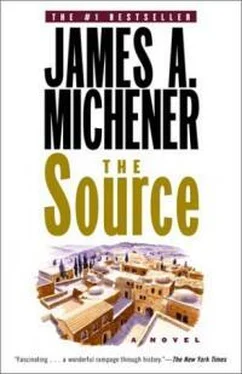Джеймс Миченер - The Source
Здесь есть возможность читать онлайн «Джеймс Миченер - The Source» весь текст электронной книги совершенно бесплатно (целиком полную версию без сокращений). В некоторых случаях можно слушать аудио, скачать через торрент в формате fb2 и присутствует краткое содержание. Год выпуска: 1983, ISBN: 1983, Издательство: Random House, Inc., Жанр: История, на английском языке. Описание произведения, (предисловие) а так же отзывы посетителей доступны на портале библиотеки ЛибКат.
- Название:The Source
- Автор:
- Издательство:Random House, Inc.
- Жанр:
- Год:1983
- ISBN:9780449211472
- Рейтинг книги:5 / 5. Голосов: 1
-
Избранное:Добавить в избранное
- Отзывы:
-
Ваша оценка:
- 100
- 1
- 2
- 3
- 4
- 5
The Source: краткое содержание, описание и аннотация
Предлагаем к чтению аннотацию, описание, краткое содержание или предисловие (зависит от того, что написал сам автор книги «The Source»). Если вы не нашли необходимую информацию о книге — напишите в комментариях, мы постараемся отыскать её.
The Source — читать онлайн бесплатно полную книгу (весь текст) целиком
Ниже представлен текст книги, разбитый по страницам. Система сохранения места последней прочитанной страницы, позволяет с удобством читать онлайн бесплатно книгу «The Source», без необходимости каждый раз заново искать на чём Вы остановились. Поставьте закладку, и сможете в любой момент перейти на страницу, на которой закончили чтение.
Интервал:
Закладка:
It was not only the presence of the engines that impressed the Crusaders; it was their astonishing number. Where an ordinary siege might have one tower, the Mamelukes had five, plus two dozen turtles, and so many horsemen they could not be counted. When all was in readiness the Mameluke general signaled by three white flags his desire for a parley, and in accordance with the custom of the age the gates of the town were opened, the drawbridge was lowered across the moat, and the main gate to the castle was thrown open to admit the general and six of his top assistants, who thus had a chance to study carefully the nature of the defenses they must finally subdue. With a kind of grim fascination Volkmar noticed that among the six were the mustachioed governor who had treated the pilgrims so graciously at Tabarie and the baldheaded man with the scar who had captained the garrison at Saphet. The Mamelukes looked straight ahead.
Their general was a short, red-faced man of forty, bearded and with long mustaches. He wore a turban beset with jewels, and no metal armor, but a costume of heavily quilted brocade richly adorned with gold and silver. His shoes were similarly decorated and came to sharp points that rose at the tip. He was armed with a short curved sword whose handle was encrusted with jewels, and he carried in his right hand an ebony baton, also bejeweled. He was a man of considerable importance and wished to get right down to work, for he had been given a terminal date by which Acre must fall and he wanted to waste no unnecessary days at the preliminary siege of Ma Coeur.
Count Volkmar mustered his knights in the courtyard so they could be seen, and directed peasants bearing lances to move about the other portions of the castle. Then he waited till the enemy general appeared, dismounted and approached, extending the hand of friendship. Volkmar took it. The men shook hands, whereupon the other Mamelukes dismounted. The leaders gathered at a table near the parapet and the Mameluke spoke first, using Arabic, which he handled awkwardly.
“Our preparations you see. You wish to surrender? Now?”
“Under what terms?”
“Your peasants, Muslim, Christian, can stay. They’ll farm their land as now,” the Mameluke began, and Volkmar smiled, thinking: They aren’t going to make the same mistakes we made at the beginning. The little general continued, “No knights killed. You select four. The rest become slaves.” At this Volkmar drew back, and the general concluded, “You, your wife, your family and the four knights. Safe-conduct to Acre.”
Coldly, and with a courage he was not aware he possessed, Volkmar asked, “The same safe-conduct that you gave the defenders of Saphet?”
The Mameluke general masked his anger—if indeed he felt any. “Since then we learned,” he said.
“To each of your proposals, no.” Volkmar spoke without accenting any word.
“The sultan directed me. I must ask you a second time.”
“And I am bound by my conscience to answer for the second time, no.”
The red-faced Mameluke bowed. Contemptuously he surveyed the castle and the assembled knights. “You may delay us perhaps one week.” He bowed again, and at the gate called back, “No man up there will come through this gate alive.” And he was off.
Still he made no move. His mangonels were primed and his turtles were ready, but he spent two more days bringing the towers up to the walls of the fortress, after which he signaled for another parley; but when the gates were opened he did not ascend to the castle but directed an assistant to speak with the villagers, after which some sixty peasants followed him out through the gates. The Christians among them were started on their way to the slave markets of Damascus and Aleppo.
Shortly after dawn on the twenty-fifth of February the siege began. The fat general in the padded suit gave signal for his trumpeters to sound alarms, and the vast army inched forward, all engines moving at the same time toward the main gate and applying such a steady pressure that by mid-afternoon the enemy was within the walls of the town. Stunned by the failure of his outer defenses, which he had calculated could resist for at least five days, Volkmar ordered his troops to fight in the streets, where determined cadres occupied the mosque, the Roman and Maronite churches and the basilica, while their companions retreated across the bridge, which was raised behind them. All who did not make their way into the castle were methodically butchered by the Mamelukes, almost without passion. The invaders did not even bother to save attractive young girls for harems; they raped them in the streets, then slaughtered them. To prove to the defenders how mortal this siege was to be, Mameluke slaves were then given the job of beheading all corpses. The ballistas were cranked up and one by one the heads were lobbed into the castle compound, where Volkmar’s men saw the grinning, rolling faces of their friends.
Count Volkmar retired to draft his next report to the men of Acre, and in it he reported his dismay at the easy collapse of the city wall:It was a wall such as I have seen withstand an ordinary army for many days, and it was courageously defended, but the Mamelukes have summoned an army of a size not hitherto known in these parts. At first, our knights estimated them to be near a hundred thousand, but I thought more like sixty. Now we are agreed that they are more than two hundred thousand, with so many engines that they cast solid shadows. They will find our castle difficult indeed and I am not apprehensive about an early defeat. We pray to God each day, and to the sweet Jesus Christ who brought our ancestors to these shores.
And with this message the next pigeon was dispatched.
Of the four defenses upon which the castle depended—glacis, town wall, moat, castle wall—the first two had given way, but knights still controlled the three churches and the mosque. Early next morning the Mameluke general inspected the town and gave orders for the reduction of those four religious buildings, and before the sun was well up the attack began. At the same time slaves began throwing rubble into the moat at those points where the wooden assault towers would be hauled into position against the castle wall. Where the moat protected the main tower the outer edge of the moat was chopped away, forming a steep path leading to the bottom of the ditch, and down this path crawled, at a hauntingly slow pace, the ominous turtles.
They were low sheds, not more than three feet high and neither wide nor long, but of immensely strong construction. Under them miners, protected from rocks or Greek fire from above, could gnaw out a tunnel beneath the foundations of the main tower. An ordinary tunnel would be so narrow that when it opened on the other side of the tower, men crawling through could easily be killed as they merged, but it was not an ordinary tunnel which the men beneath the turtles were digging.
To the edge of the moat were moved the largest ballistas, and when they were in position they began lobbing huge rocks into the castle buildings, and the Mamelukes cheered as one giant boulder crashed through the stone lacework of the grand hall, ripping away part of the wall. Next the mangonels were cranked up and their lethal arrows placed against the strings, and when the machine let go, the arrows winged with sickening force against the men of the wall, and if a defender was caught by such an arrow it went completely through him and he toppled backward from the parapet.
Count Volkmar’s men were not powerless. When the slaves approached the moat to cast their rubble, arrows and rocks drove them back and many were killed; when the turtles tried to work their way into the bottom of the moat the defenders dropped large round rocks down the face of the wall, and the flange at the bottom would send the rocks careening through the massed troops, tearing away legs and arms. But their most effective weapons were the clay jugs of Greek fire—naphtha and sulphurous compounds, set ablaze by red-hot flints—that burned even on water and could be extinguished only by vinegar or talc. It blinded soldiers or burned away their faces, and constantly, from each round tower so carefully positioned by Gunter, a stream of iron-tipped arrows sped at any Mameluke who tried to approach the glassy-surfaced walls. At this point Count Volkmar decided to conserve his pigeons, so as midnight approached he directed his men to haul onto the highest tower of the castle a pile of brush, and he and his son climbed the winding stairs with a torch, throwing vast shadows on the rock; and they lit the brushwood in the ancient manner so as to signal throughout the hills of Galilee and across to Acre itself the fact that at the castle of Ma Coeur all was well.
Читать дальшеИнтервал:
Закладка:
Похожие книги на «The Source»
Представляем Вашему вниманию похожие книги на «The Source» списком для выбора. Мы отобрали схожую по названию и смыслу литературу в надежде предоставить читателям больше вариантов отыскать новые, интересные, ещё непрочитанные произведения.
Обсуждение, отзывы о книге «The Source» и просто собственные мнения читателей. Оставьте ваши комментарии, напишите, что Вы думаете о произведении, его смысле или главных героях. Укажите что конкретно понравилось, а что нет, и почему Вы так считаете.








![Джеймс Купер - Пионеры, или У истоков Саскуиханны [The Pioneers, or The sources of the Susquehannah]](/books/395797/dzhejms-kuper-pionery-ili-u-istokov-saskuihanny-t-thumb.webp)

